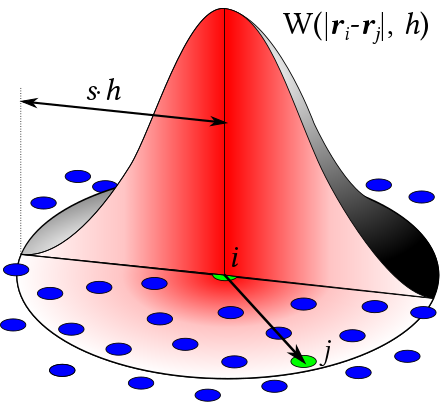Lagrange fluid simulation: Smoothed particle hydrodynamics
High-level idea: use particle carrying samples of physical quantities, and a kernel function $W$, to approximate continuous fields:

- Originally proposed for astrophysical problems
- No meshes. Very suitable for free-surface flows!
- Easy to understand intuitively: just imagine each particle is a small parcel of water (although strictly not the case)
Implementing SPH using the Equation of States (EOS)
Also know as Weakly Compressible SPH (WCSPH).
Momentum equation: ($\rho$: density; $B$: bulk modulus; $\gamma$: constant, usually $\sim 7$ )
Gradients in SPH
- Not really accurate
- But at least symmetric and momentum conversing
Now we can compute $\nabla p_i$
SPH Simulation Cycle
For each particle $i$, compute $\rho_i= \sum_j{ m_j W \left( ||\textbf{x} - \textbf{x}_j||_2, h \right)}$
For each particle $i$, compute $\nabla p_i$ using the gradient operator
Symplectic Euler step:
Variants of SPH
- PCI-SPH: Predictive-Corrective Incompressible SPH
- PBF: Position-based fluids
- DFSPH: Divergence-free SPH
Courant-Friedrichs-Lewy (CFL) condition
One upper bound of time step size:
- $C$: CFL number (Courant number, or simple the CFL)
- $\Delta t$: time step
- $\Delta x$: length interval (e.g. particle radius and grid size)
- $u$: maximum (velocity)
Application: estimating allowed time step in (explicit) time integrations. Typical $C_{max}$ in graphics:
- SPH: ~ 0.4
- MPM: 0.3 ~ 1
- FLIP fluid (smoke): 1 ~ 5+
Accelerating SPH: Neighborhood search
So far, per sub-step complexity of SPH is $O(n^2)$. This is too costly to be practical. In practice, people build spatial data structure such as voxel grid to accelerate neighborhood search. This reduces time complexity to $O(n)$.
Reference: Compact Hashing
Extend reading
SPH Fluids in Computer Graphics: https://cg.informatik.uni-freiburg.de/publications/2014_EG_SPH_STAR.pdf
A tutorial for SPH: Smoothed Particle Hydrodynamics Techniques for the Physics Based Simulation of Fluids and Solids